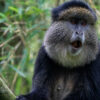Uganda is one of the most beautiful countries in Africa. With its dense misty forests, snow-peaked mountains, glassy lakes and sprawling savannas. Mountain gorillas are the allure for many visitors, but there’s an astounding variety of attractions for tourists. To visit these different destinations and attractions, you will need to know the best time to go.
Safaris in Uganda are best done during drier months of the year because of the best weather, sightings and accessibility.
Travelling in December is one of the best times to do a safari in Uganda, and it is the busiest month of the year and lodges are usually booked in advance. In fact, if you are searching for the best time to visit gorillas in Uganda then we suggest you book your safari (plus permits) in not less than 6 months in advance to secure a good slot for December because tourists compete for good accommodation facilities several months in advance besides purchasing permits for the most visited gorilla families.
About the climate, what you should know is Uganda’s rain comes twice in a year; In other words, Uganda has only two rainy seasons. The months of March to May are usually accompanied by extremely heavy rainfall, which leaves the weather unpredictable unlike the months of October and November that have little rainfall. To contradict this, is believe Uganda is an all-year travel destination because of its location on the equator. The temperatures range between 23 – 29 degrees Celsius implicating you can still enjoy your safari during the rainy months. The only obstacle you might face is your safari vehicle getting stuck on the muddy roads of the national parks unless you are travelling in a 4×4 tour vehicle.
The best game viewing months in Uganda are during the dry seasons that range from June, July and August as well as December, January and February. Primate walks in the forest are a big part of any safari in Uganda. The habitat of rain forests is, by default, very wet and one can’t avoid rain completely. However, after heavy rains, the sky usually opens up to bright sunshine.
It’s the good time to track gorillas because these are the drier months. The skies are clear, there is less rain and more sunshine. It’s easier to spot wildlife in the Savannah reserves since vegetation is less and animals gather around water sources. Despite being a high season month, the parks don’t feel crowded. Gorilla permits need to be booked very far in advance.
During these months, wildlife is available in plenty unlike in wet months where they tend to take shelter from the rain which might cause you to see them in less numbers especially for mountain gorillas.
March up to May and September up to November (Wet Season): The vegetation is greener and its low season, resulting in lower rates. Although wildlife in the Savannah reserves is easier to spot in the dry season, you’ll still see plenty, including newborn animals in the wet season. The scenery of Savannah plains is much greener during wet months too which might prevent you from getting exceptional views from the respective national parks especially Kidepo valley National Park and Murchison Falls National Park.
However, some of the roads get very bad and cars often get stuck. Forest trails can become slippery and challenging. If it pours with rain, changes can’t be made in the expensive gorilla permit. Departures go on as scheduled.










